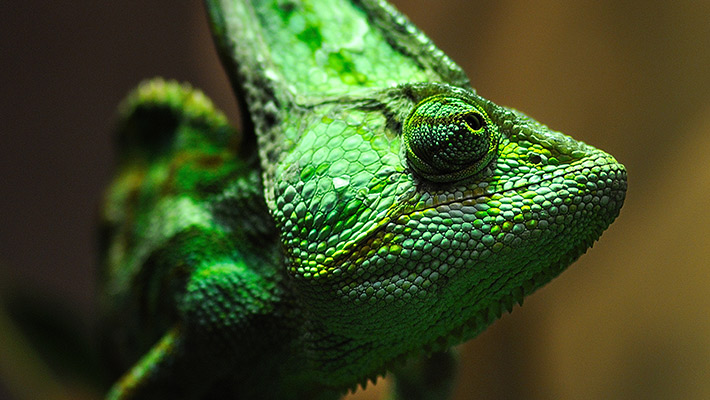Learn about The Veiled Chameleon
Scientific name: Chamaeleo calyptratus
Conservation status: Least concern
Environmental Threats: Habitat destruction – deforestation. Roadkill. Illegal collection from the wild.
Lifespan: Wild = unknown. Captivity = 5 to 8yrs
Reproduction: 30 to 95 eggs per clutch. 6 months incubation.
Care for Young: Hatchlings are fully self-sufficient.
Size: 25cm to 60cm
Weight: 85 to 170 grams
Life Balance
Solitary tree-dwellers, the arboreal Veiled Chameleon use their grasping feet and prehensile tail to help them hold on tight to branches and shrubs.
What does a Veiled Chameleon eat?
A Veiled Chameleon is an Insectivore – it eats insects and occasional leaves.
All Hail the Veil
The Veiled Chameleon gets its name from the bony protrusion atop its head, which is called a casque. Both males and females sport the avant-garde headpiece, though it is much larger on males, it serves to channel water droplets, at night, droplets of moisture roll down the casque and into the chameleon's open mouth! A crucial adaptation in their dry habitats. The casque grows larger with age.
Colour Chameleon
Veiled Chameleons are born pastel green and as they grow they become more colourful through maturation. Like many chameleons, this species can change colour within seconds with the help of special pigmented cells in their skin. Their variable colour changes can be a response to a variety of factors, including to show aggression, social status, reproduction, and stress. Males will use their colour variations when challenging other males for dominance and when trying to attract females for mating.
Fast Food
Chameleons don't move around very fast, so they use their extraordinary long tongue to catch the insects they eat. They can shoot their tongue out fast! With a sticky tip on the end of the tongue, this allows the chameleon to snag insect prey that they would otherwise never be able to catch. The end of the tongue is a ball of muscle, and as it hits its prey, it quickly forms a small suction cup. Once the prey is stuck to the tongue, the chameleon draws it back into the mouth, where its strong jaws crush it for swallowing. The tongue is kept bunched up at the back of the mouth until it is needed for another ‘fast food’ meal.
Eye Spy
The Veiled Chameleon has very distinctive eyes. Each eye has a scaly lid shaped like a cone, with only a small, round opening in the middle for the pupil. The chameleon can rotate and focus its eyes separately to look at two different objects at the same time! This gives it a full 360-degree view around its body and both eyes can focus on the same direction to get a clearer view when feeling threatened or zoning in on a meal.
